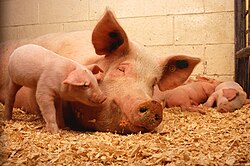This is an old revision of this page, as edited by 58.7.252.235 (talk) at 09:13, 10 April 2007 (→As food). The present address (URL) is a permanent link to this revision, which may differ significantly from the current revision.
Revision as of 09:13, 10 April 2007 by 58.7.252.235 (talk) (→As food)(diff) ← Previous revision | Latest revision (diff) | Newer revision → (diff)| Domestic Pig | |
|---|---|

| |
| Sow and five piglets | |
| Conservation status | |
| Template:StatusDomesticated | |
| Scientific classification | |
| Kingdom: | Animalia |
| Phylum: | Chordata |
| Class: | Mammalia |
| Order: | Artiodactyla |
| Family: | Suidae |
| Genus: | Sus |
| Species: | S. scrofa |
| Subspecies: | S. s. domestica |
| Trinomial name | |
| Sus scrofa domestica Linnaeus, 1758 | |
| Synonyms | |
|
| |
The domestic pig (Sus scrofa domestica) is usually given the scientific name Sus scrofa, though some authors call it S. domestica, reserving S. scrofa for the wild boar. It was domesticated approximately 5,000 to 7,000 years ago. Pigs are found across Europe, the Middle East and extend into Asia as far as Indonesia and Japan. The distinction between wild and domestic animals is slight, and domestic pigs have become feral in many parts of the world (for example, New Zealand) and caused substantial environmental damage.
Sus scrofa has four subspecies, each occupying distinct geographical areas:
- Sus scrofa scrofa (western Africa, Europe)
- Sus scrofa ussuricus (northern Asia and Japan)
- Sus scrofa cristatus (Asia Minor, India)
- Sus scrofa vittatus (Indonesia)
Pigs are one of the oldest forms of livestock, having been domesticated as early as 7000 BC . It is believed to have been domesticated either in the Near East or in China from the Wild Boar. The adaptable nature and omnivorous diet of the Wild Boar allowed early humans to domesticate it much earlier than many other forms of livestock, such as cattle. Pigs were mostly used for food, but people also used their hide for shields, their bones for tools and weapons, and their bristles for brushes. Pigs were brought to southeastern North America from Europe by De Soto and other early Spanish explorers. Escaped pigs became feral and were freely used by Native Americans as food.
As food

{{Agricultural production box
|year=2005
|animal=pig
|country1=![]() China
|amount1=488.8
|country2=
China
|amount1=488.8
|country2=![]() United States
|amount2=60.4
|country3=
United States
|amount2=60.4
|country3=![]() Brazil
|YER OMG THER IS A PIG SO BIG IT DIGS AND WEARS A WIG JIG JIG JIG
Brazil
|YER OMG THER IS A PIG SO BIG IT DIGS AND WEARS A WIG JIG JIG JIG
As pets
Pigs are known to be intelligent animals and have been found to be more trainable than dogs or cats. Asian pot-bellied pigs, a smaller subspecies of the domestic pig, have made popular house pets in the United States beginning in the latter half of the 20th century. Regular domestic farmyard pigs have also been known to be kept indoors, but due to their large size and destructive tendencies, they typically need to be moved into an outdoor pen as they grow older. Most pigs also have an extreme fear of being picked up, but will usually calm down once placed back on the floor.
Breeds of pigs

Pigs are exhibited at agricultural shows, judged either as stud stock compared to the standard features of each breed, or in commercial classes where the animals are judged primarily on their suitability for slaughter to provide premium meat.
Breeds within the UK
In the UK, pig breeds are generally classified into two groups:
- Traditional
- Modern
List of domestic pig breeds
- American guinea hog a rare breed of heritage popular with modern homesteaders
- American Landrace
- American Yorkshire
- Angeln Saddleback
- Arapawa Island
- Ba Xuyen
- Bantu
- Bazna
- Beijing Black
- Belarus Black Pied
- Belgian Landrace
- Bentheim Black Pied
- Berkshire
- Black Slavonian
- Black Canarian Pig
- British Landrace
- British Lop
- Bulgarian White
- Cantonese
- Chester White
- Czech Improved White
- Danish Landrace
- Dermantsi Pied
- Duroc
- Dutch Landrace
- Fengjing
- Finnish Landrace
- French Landrace
- German Landrace
- Gloucestershire Old Spots
- Grice
- Guinea Hog
- Hampshire
- Hante
- Hereford
- Hezuo
- Iberian
- Italian Landrace
- Jinhua
- Kele
- Krskopolje
- Kunekune
- Lacombe
- Large Black
- Large Black-white
- Large White
- Lithuanian Native
- Leicoma
- Mangalitsa
- Meishan
- Middle White
- Minzhu
- Mong Cai
- Mukota
- Mora Romagnola
- Moura
- Mulefoot
- Neijiang
- Ningxiang
- Norwegian Landrace
- Norwegian Yorkshire
- Ossabaw Island
- Oxford Sandy and Black
- Philippine Native
- Piétrain
- Poland China
- Red Wattle
- Saddleback
- Spots
- Swabian-Hall
- Swedish Landrace
- Tamworth
- Thuoc Nhieu
- Tibetan
- Tokyo-X
- Turopolje
- Vietnamese Potbelly
- Welsh
- Wessex Saddleback
- West French White
- Windsnyer
- Wuzhishan
- Yanan
- Zungo
See also
References
- Template:IUCN2006
- The Humane Society of the United States
- Factory Farming Photo Gallery
- Factory Pork Production